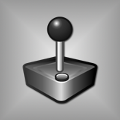Games
Displaying 11471-11480 of 15808 results.
Sony Playstation 2
Release Date: March 20, 2007 |
Genre: Action, Role-Playing
A bitter war between two world superpowers has raged on for decades with armies of beasts and demons devastating the people and the land. With both sides deadlocked, two young heroes rise up to begin a heroic journey to stop the fighting and unite the divided world. As either Toma, a talented sword fighter boy, or Cyrille, a cunning female sorceress, you'll venture into a stunning world of swords and sorcery teeming with a huge variety of tribes. With aggressive offensive and defensive strategies, you'll lead your battle party into combat while protecting your home base, the Geo Fortress, from massive attacks.
Sega Genesis
Release Date: October 19, 1994 |
Genre: Role-Playing
Shining Force II is a tactical role-playing game. The player assumes the role of the Shining Force leader, Bowie. When not in combat, the player can explore towns and other locales, talk with people, and set the members and equipment of the army. Some towns have a headquarters where the player can inspect and talk with his allies. While roaming through town or moving throughout the world, one can find both visible and hidden treasures and interact with certain objects.
Each ally unit is represented by a character with a background and personality. Some of these characters are hidden, requiring specific events to occur before they will join the force. Each ally unit also has a class, which defines the abilities for that unit. These abilities range from what type of weapons they can use to what kind of spells they can learn. Units can become stronger by fighting enemies and performing various actions which gives them experience points (EXP), which allow them to gain levels. Once a unit reaches level 20, that character has the ability to advance to more powerful class through promotion. Some characters have two different classes they may be promoted to, one of which is only accessible using a special hidden item.
Battles take place on a square grid, and each unit occupies a single square. Battle is turn-based. Each turn, a character can move and perform one action: either attack, cast a spell, or use an item. Some commands, such as equipping or dropping an item during the turn, do not count as actions.
The battle is won if all enemies are defeated, or if the enemy commander is defeated. If Bowie is defeated in combat or withdraws, the battle is lost and the player is returned to the nearest town, where he can recover his allies and fight the same battle again.
Sega Saturn
Release Date: August 12, 1998 |
Genre: Role-Playing, Strategy
Scenario 1, God Warrior of the Kingdom, features Synbios, a young general from the Republic of Aspinia. Aspinia was once a part of the Empire of Destonia, but seceded after a war of independence spearheaded by some of the more democratic-minded nobles. They opposed Emperor Domaric's totalitarian policies, which disenfranchised a large number of people, creating a huge disparity between the wealthy and the poor. Tensions remained between Aspinia and Destonia after the secession, marked by occasional border disputes.
As the game begins, Synbios is part of a military force representing Aspinia at a peace conference in the neutral city of Saraband. Due to manipulation by outside forces - later discovered to be connected with a religious cult known as the "Bulzome Sect" - full-scale war breaks out again between Aspinia and Destonia. The majority of the game's storyline covers this conflict as well as Synbios and his team's fight against the Bulzome sect. Throughout the game Synbios has periodic encounters with Medion, Destonia's youngest prince, who also recognizes the truth behind the war. Although on opposite sides of the war, the two work together to identify the real threat.
Sega Saturn
Release Date: April 29, 1998 |
Genre: Role-Playing, Strategy
Scenario 2, Target: Child of God, features Medion, Prince of Destonia, and youngest of three sons of Emperor Domaric. Although loyal to his father and his country, he senses that there are other forces at work beneath the tensions between Aspinia and Destonia. He attends the conference in Saraband on behalf of Destonia, along with his brothers Arrawnt and Mageron. As discovered in Scenario 1, much of this influence comes from the Bulzome sect, as well as collaborating separatist factions within both Destonia and Aspinia. Medion works parallel to Synbios of Aspinia, often disposing of rogue Aspinian elements to spare Synbios's force from fighting against its own countrymen. At the end of the game, Medion is forced to battle with Synbios' force when Julian steps in to stop them.
Sega Saturn
Release Date: September 23, 1998 |
Genre: Role-Playing, Strategy
Scenario 3, Bulzome Rising, stars Julian, a mercenary who appears as a secondary character in both Scenario 1 and Scenario 2. He is for all intents and purposes the true main character of Shining Force III. His initial motivation as the story begins is to track down and kill Galm, one of, if not the, most powerful member of the Vandals, a powerful race of beings that existed over 1,000 years ago. Julian believes that Galm killed his father and is seeking revenge. This story arc is first introduced in an earlier Shining game, Shining the Holy Ark, in which Julian appears as a young boy who asks the party to search for his missing father.
Julian joins Synbios in the midst of his quest in Scenario 1, but after an encounter with Galm, he is tossed over a waterfall at the suspension bridge and believed by Synbios' army to be dead. He reappears in Scenario 2, apparently washing ashore at the site of a battle between Medion's army and the Bulzome Sect. Knowing the sect's ties to the Vandals, Julian agrees to fight alongside Medion. As it becomes clear that the sect is trying to kill Gracia, a child intended to become the next Innovator (A Shining Series figure equatable to a god), Julian takes on the task of protecting him and helping him realize his destiny.
Scenario 3 starts about 60% through scenario 2's story, and focuses primarily on battles against the Bulzome Sect and their allies in both Aspinia and Destonia. While scenarios 1 & 2 happen at roughly the same time, much of scenario 3 takes place after both, but there is some "overlap". Eventually Julian leads a three-party coalition consisting of the armies of both Synbios and Medion, to engage in the final conflict against Bulzome, a powerful Vandal long sealed in another dimension, and the true orchestrator of the conflict.
Sega Saturn
Release Date: December 3, 1998 |
Genre: Role-Playing, Strategy
If you're unfamiliar with Shining Force III, or just not a fan, the Premium Disc will have little significance to you. If you are a fan, however, the Shining Force III Premium Disc is likely the greatest and most interesting bonus disc released for a game to date.
Sony Playstation 2
Release Date: October 20, 2005 |
Genre: Action, Role-Playing
Max completes his Force military training and returns to his village to meet his family and to find news of his missing brother. Later, the village is attacked by monsters later suspected as remnants of the Legion as well as the appearance of a mysterious figure that seems to know of his brother. This reasons compel Max to seek out the Legion threat, hoping in the process to also find his missing brother.
Nintendo Game Boy Advance
Release Date: June 8, 2004 |
Genre: Role-Playing
Shining Force is a turn-based tactical RPG. Battles take place in square grids, and each unit occupies one square. Each unit can move up to a fixed amount of squares along the battlefield, determined by its Move statistic. Depending on its location relative to enemies and to allies, a unit can also perform one action: attack, cast a spell, use an item, or search the area. Some commands, such as equipping or dropping items, don't count as actions. The order of turns is determined by the unit's agility score and a random seed.
As is most common for the RPG genre, units become stronger by fighting enemies or by performing other actions in battle, such as healing allies. These actions give the units experience points (EXP.), which allow them to gain levels.
In Shining Force, each allied unit is represented by a character with his or her own background and personality, much like in the Fire Emblem series. Although there are no "generic" units, except on the enemy side, most characters contribute little or nothing to the plot upon joining the player army.
Each allied unit also has a class, which defines a set of abilities for that unit and determines the spells and equipment they have access to. A unit can be promoted to another class at any level between 10 or 20. Upon promotion the character's level resets to 1 and statistics are reduced by a fixed amount, although they begin higher if the character had been promoted at a higher level.
Battle goals for the player are fairly simple: kill all enemies, kill the enemies' leader, or advance to a town or landmark. The enemy side wins if they kill the player's leader, Max, or if the player chooses to escape the battle by casting Egress. Even if the player army is defeated, the player can recover allies and retry the battle. The Force keeps any experience that is obtained, regardless of the battle's outcome. Thus, there is no Game Over, and the player's army gets stronger even upon its defeat, although Max's death results in the player losing half of their money.
Most games in the Shining Force series (with the exceptions of Shining Force CD, all three Game Gear games, all five cell phone games, the Shining Force III premium disc, the Shining Force for Palm Pilot game, and Shining Force Feather) also possess an exploration mode that occurs outside of battle. This gameplay mode is essentially a Japanese-style traditional RPG game, along the lines of Final Fantasy or Dragon Quest, although there are no labyrinths and few puzzles to solve. In this mode, the player's army is represented by Max, who is able to walk around, interact with people, find treasure, buy equipment and items, outfit the army, and choose which of the army's members will be used in battle.



